Samsung Portable SSD T5 Review: 64-Layer V-NAND Debuts in Retail
by Ganesh T S on August 15, 2017 10:00 AM ESTAnandTech DAS Suite and Performance Consistency
This section looks at how the Samsung Portable SSD T5 behaves when subject to real-world workloads.
Benchmarks - robocopy and PCMark 8 Storage Bench
Our testing methodology for DAS units also takes into consideration the usual use-case for such devices. The most common usage scenario is transfer of large amounts of photos and videos to and from the unit. The minor usage scenario is importing files directly off the DAS into a multimedia editing program such as Adobe Photoshop.
In order to tackle the first use-case, we created three test folders with the following characteristics:
- Photos: 15.6 GB collection of 4320 photos (RAW as well as JPEGs) in 61 sub-folders
- Videos: 16.1 GB collection of 244 videos (MP4 as well as MOVs) in 6 sub-folders
- BR: 10.7 GB Blu-ray folder structure of the IDT Benchmark Blu-ray (the same that we use in our robocopy tests for NAS systems)





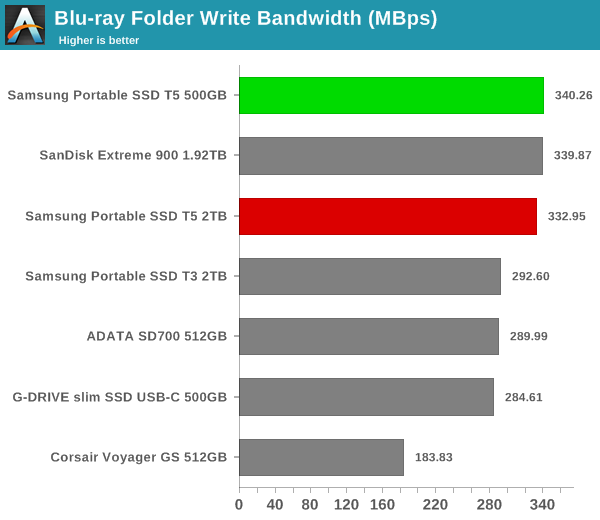
For the second use-case, we take advantage of PC Mark 8's storage bench. The storage workload involves games as well as multimedia editing applications. The command line version allows us to cherry-pick storage traces to run on a target drive. We chose the following traces.
- Adobe Photoshop (Light)
- Adobe Photoshop (Heavy)
- Adobe After Effects
- Adobe Illustrator
Usually, PC Mark 8 reports time to complete the trace, but the detailed log report has the read and write bandwidth figures which we present in our performance graphs. Note that the bandwidth number reported in the results don't involve idle time compression. Results might appear low, but that is part of the workload characteristic. Note that the same testbed is being used for all DAS units. Therefore, comparing the numbers for each trace should be possible across different DAS units.


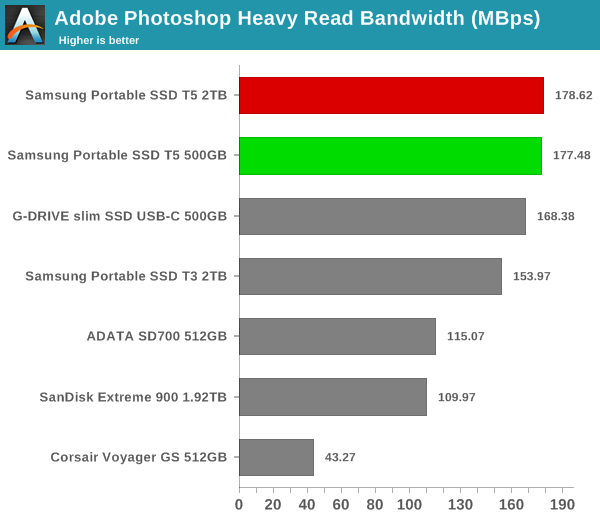

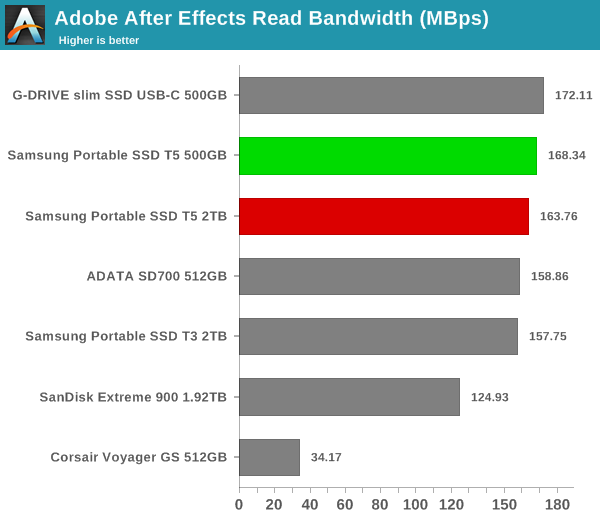
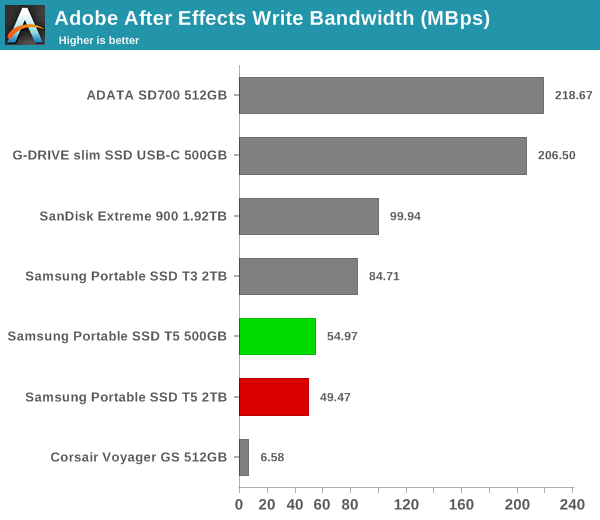
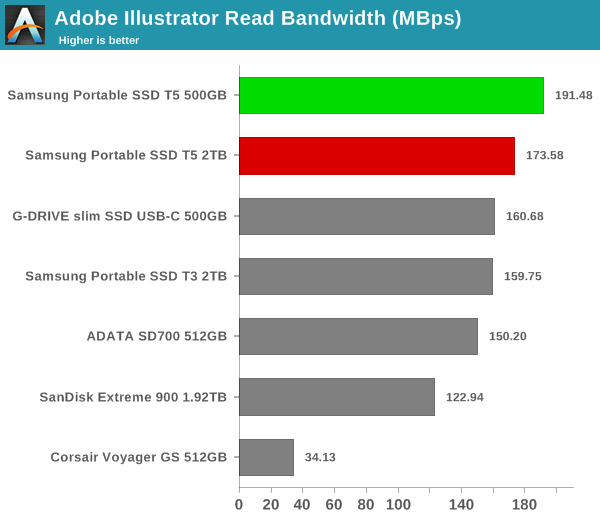

Performance Consistency
Yet another interesting aspect of these types of units is performance consistency. Aspects that may influence this include thermal throttling and firmware caps on access rates to avoid overheating or other similar scenarios. This aspect is an important one, as the last thing that users want to see when copying over, say, 100 GB of data to the flash drive, is the transfer rate going to USB 2.0 speeds. In order to identify whether the drive under test suffers from this problem, we instrumented our robocopy DAS benchmark suite to record the flash drive's read and write transfer rates while the robocopy process took place in the background. For supported drives, we also recorded the internal temperature of the drive during the process. The graphs below show the speeds observed during our real-world DAS suite processing. The first three sets of writes and reads correspond to the photos suite. A small gap (for the transfer of the videos suite from the primary drive to the RAM drive) is followed by three sets for the next data set. Another small RAM-drive transfer gap is followed by three sets for the Blu-ray folder.
An important point to note here is that each of the first three blue and green areas correspond to 15.6 GB of writes and reads respectively. Throttling, if any, is apparent within the processing of the photos suite itself. We see no throttling in the T5, though the temperatures do run a bit more compared to the T3.
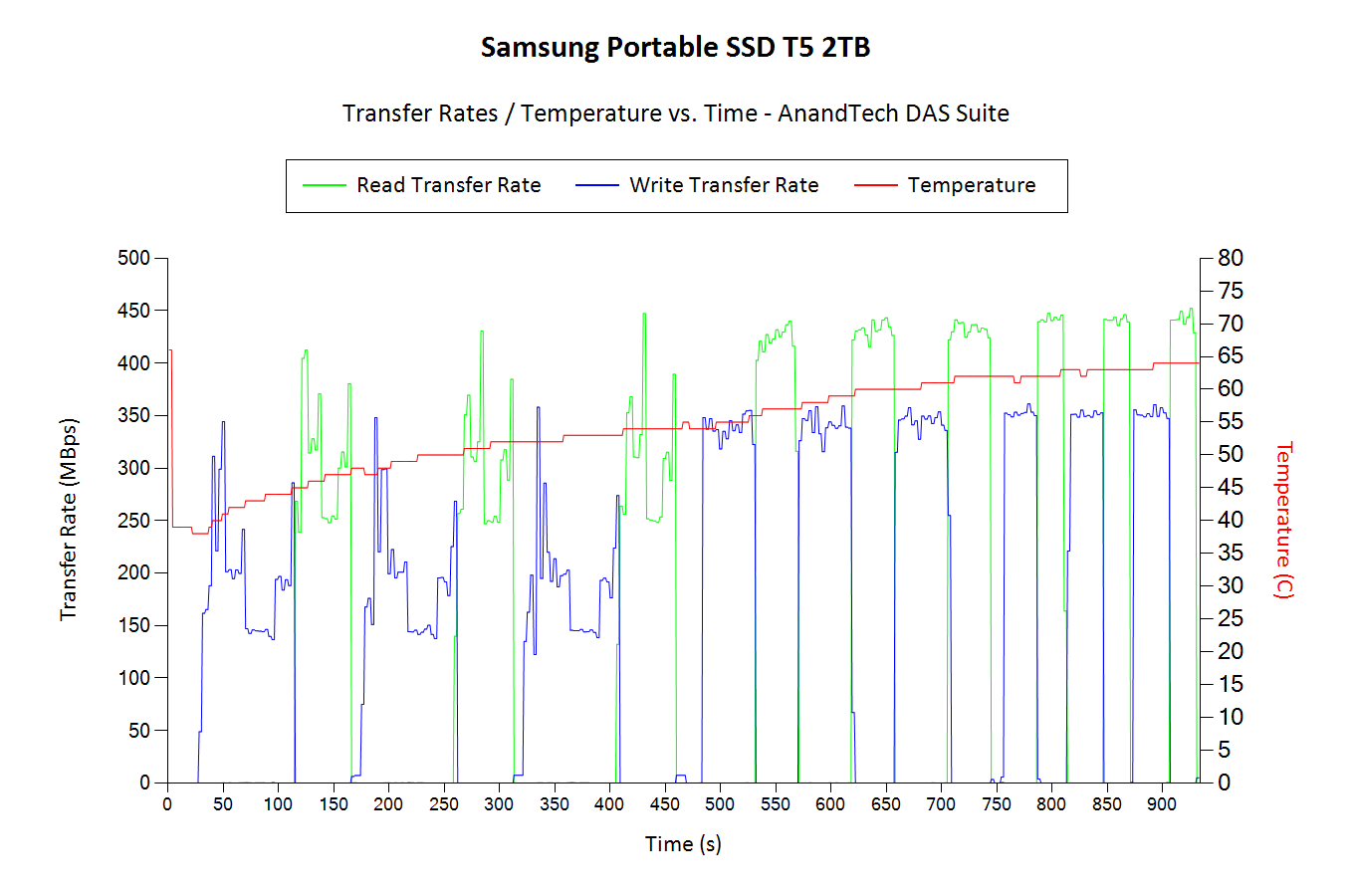
On the whole, the 500GB variant seems to hold a very slight edge in performance over the 2TB variant. In many of the workloads, the RAID-ed SanDisk Extreme 900 comes out on top. That said, both the T5 variants are consistent performers in our real-world benchmarks.










38 Comments
View All Comments
timecop1818 - Tuesday, August 15, 2017 - link
what workload on a Macintosh would require so much data transfer anyway? you don't need 3000mb/sec to stare at a desktop or play candy crushjdshewman - Wednesday, August 16, 2017 - link
Photographers, HD and 4K video. With the abundance of travel bloggers and drones, extra storage with speed is valuable.AnTech - Thursday, August 17, 2017 - link
Which one? Any of these or is there anyone else coming?Sonnet Fusion Thunderbolt 3 PCIe Flash Drive
http://www.sonnettech.com/product/fusiontb3pciefla...
JMR Lightning LTNG-XTD portable Thunderbolt SSD
http://jmr.com/product/jmr-lightningltng-xtd-porta...
name99 - Wednesday, August 16, 2017 - link
Of course it is. Macs have handled booting from external drives since forever (at least the initial FireWire days). I run my iMac 2012 off an external USB3 SSD because the internal HD failed. Hell, you can even create a fusion boot drive between an external SSD and an internal hard drive if you like, and that's how I run my 2007 iMac (SSD connected via FW800).Being able to boot painlessly from external drives is one of the great Mac advantages that Win and Linux folks don't seem to know about because it's not part of their world. I do it all the time, sometimes for machines whose internal drives die, sometimes to give a speed boost to an old machine (like the 2007 iMac setup I described above), sometimes as a diagnostic when a machine seems to be behaving badly. (Good way to learn/test that an internal HD is going bad...)
Obviously you will want to format the external drive to JHFS+ (or wait two months and format it to APFS...), you can't boot off exFAT or NTFS or whatever it comes formatted with.
VulkanMan - Tuesday, August 15, 2017 - link
How long can these retain the data without being powered?Is that information included anywhere?
coder543 - Tuesday, August 15, 2017 - link
No one lists that information for any SSD that I've seen, but the minimum JEDEC spec for a consumer SSD is one year without power. Realistically, I have trouble imagining less than 5 years being a problem, but it would be interesting to have numbers.VulkanMan - Tuesday, August 15, 2017 - link
Most SSDs have been internal and those usually get powered up daily / weekly.Since these are external, not everyone is going to know that they must power the devices up at least once every X months, so they shouldn't be used for long term storage.
I would think they would put warnings on these that data loss is possible if you don't power them up semi-frequently.
Billy Tallis - Tuesday, August 15, 2017 - link
Powering up the drive periodically or even continuously doesn't solve anything. All of the data has to be moved or re-written in order to prolong retention times. But since those retention times are measured in years not months, it's not worth warning about.Billy Tallis - Tuesday, August 15, 2017 - link
JEDEC spec is for one year of unpowered data retention after the drive's rated write endurance has been exhausted. A drive that hasn't been absolutely hammered with writes will retain data far longer.Bullwinkle J Moose - Tuesday, August 15, 2017 - link
I'll stick with an 850 Pro because it works on any USB 3 and 3.1 port with an adapterThe 850 Pro is faster than this drive as well
I avoid "USB Only" external drives because you can only install Windows 2 Go Spyware Platforms on them
With the 850 Pro, I can also install Windows XP and use it with SATA and ESATA ports as well as any USB port
With this one, you are stuck with USB only
So sad!